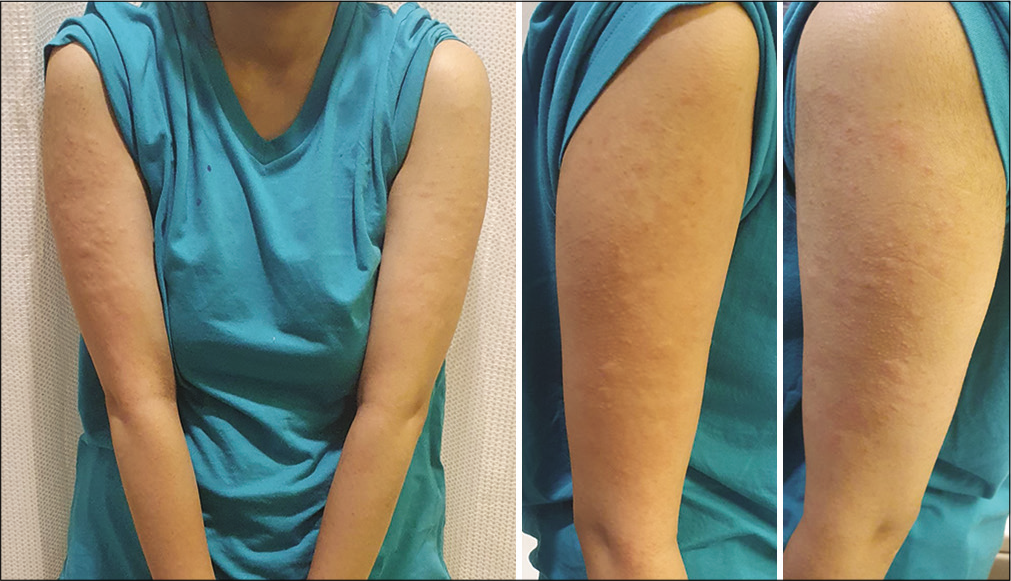Translate this page into:
Follicular traction urticaria: Reporting a rare case
*Corresponding author: Tapan K Dhali, Department of Dermatology, Venereology and Leprosy, ESI Post Graduate Institute of Medical Sciences and Research, New Delhi, India. tapan99@gmail.com
-
Received: ,
Accepted: ,
How to cite this article: Bhattacharya I, Dhali TK. Follicular traction urticaria: Reporting a rare case. Indian J Skin Allergy 2022;1:24-5.
Dear Sir,
Follicular traction urticaria (FTU) has recently been introduced as a new type of chronic inducible urticaria which involves the development of wheals after hair traction or hair removal in the absence of underlying dermographism. Only seven other cases have been reported in the English literature. To the best of our knowledge, this is the 8th case in the world and the first such case from India.[1,2]
A 25-years-old female presented with multiple wheals ranging from size 2 × 2 cm to pinpoint, over bilateral upper limbs, predominantly over the extensor aspects [Figure 1]. The wheals had appeared 5–15 mins after waxing and persisted for more than 20 hours. Patient reported similar such episodes in the past, with waxing triggering small pinpoint papules which vanished on their own in 30 min but this was the first time she had developed larger more persistent wheals. Patient also reported taking tablet Levocetirizine 5mg but with no relief which prompted a dermatologic consult.

- Multiple follicular wheals over sites of hair traction.
She had no history of allergies or urticaria. Test for Dermographism was negative. Provocation test with gentle hair traction using a tweezer was also negative. Provocation test with forceful removal of waxing strip triggered similar lesions [Figure 2].

- Provocation test with forceful removal of waxing strip triggered similar lesions.
Based on the sudden onset of wheals after a hair removal procedure, the limitation of wheals to the areas subjected to waxing, history of similar such lesions in the past, and a positive provocation test, a diagnosis of FTU was made.
Gallo et al. in 2009 first used the term “Physical Urticaria” for a patient who developed wheals after removal of patch tests. It was hypothesized that this was triggered due to skin traction.[3] In 2012, Ozkaya et al. noted that these wheals were exclusively due to hair traction and renamed this form of urticaria as “Follicular traction Urticaria.”[4]
Duman et al. in 2016 suggested that hair traction (rather than skin traction) specifically releases a different kind of antigen that interacts with IgE sensitized mast cells around the hair follicle, which could be responsible for the above phenomenon.[5] So far, FTU has only been reported in young females with the absence of any history of urticaria or dermographism.
Notably, among the seven other such reported cases in English literature, six cases had wheals lasting for less than 3 h. Our case is more similar to the one reported by RaisonPeyron[6] in whom the wheals lasted 15–18 h. The longer duration is probably due to the force of traction applied and more studies are required to further explore this.
Clinically, FTU needs to be differentiated from pseudo-folliculitis, transient non-itchy papular eruption after epilation, and follicular dermographism.
This case is a rare and unusual case of acute FTU and these patients are highly sensitive to stimulation of perifollicular mast cells. Such patients should opt for other gentler methods of hair removal like shaving or hair removal creams. In the event that waxing has to be undertaken, these patients should be advised to take prophylactic antihistamines before and after the procedure to suppress such reactions. FTU should also be considered as a differential in the evaluation of physical urticarias with predominantly follicular wheals.
Declaration of patient consent
The authors certify that they have obtained all appropriate patient consent.
Financial support and sponsorship
Nil.
Conflict of interest
There are no conflict of interest.
References
- Follicular traction urticaria: An occult case diagnosed by patch testing. Dermatitis. 2019;30:171-3.
- [CrossRef] [PubMed] [Google Scholar]
- Follicular traction urticaria induced by electric epilation. Cutis. 2020;105:E23-4.
- [Google Scholar]
- Follicular traction urticaria. J Am Acad Dermatol. 2012;67:e234-6.
- [CrossRef] [PubMed] [Google Scholar]
- Follicular traction urticaria: A new form of chronic inducible urticaria? Acta Derm Venereol. 2017;97:522-3.
- [CrossRef] [PubMed] [Google Scholar]





